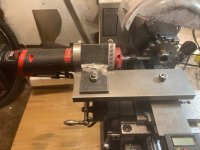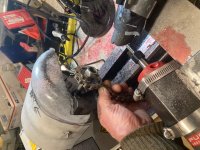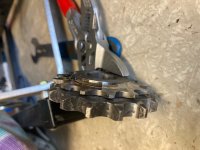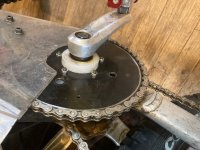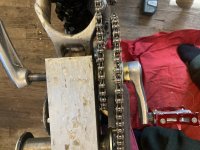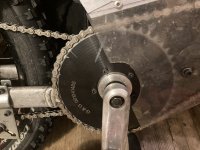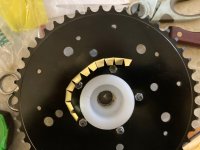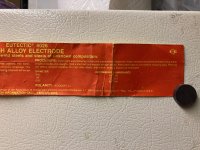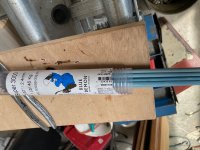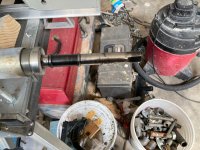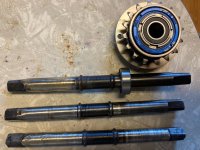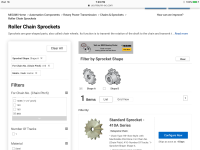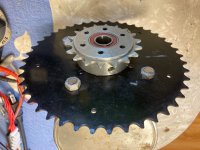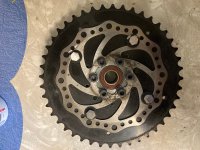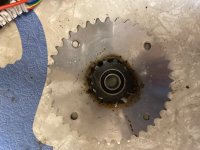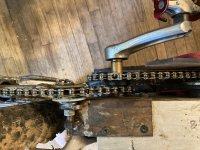Installing Motor Sprocket Tightening Bolt on End of Motor Shaft
The task of drilling and taping on the QS motor shafts is quite difficult due to the very high degree of case hardening on the motor shaft. The wide splined motor shaft gets bigger towards the motor side after parallel matchineing for a distance wider than a motor sprocket. A motor sprocket forced onto the wider splines gets very tight & secure which is desired. Forcing a motor sprocket onto the wider splines is not easily done with the IOM QS lockring nor by an added external milled snap ring that just fits very snug.

To tap threads into highly hardened steel necessitates carbide drills and carbide taps -- plus very careful work to keep from breaking the solid carbide tools. A carbide drill mill and a carbide tap from MaMater-Carr costs $123. I could get these two tool on eBay for $39 -- perhaps inferior but maybe they could do the job?
An earlier attempt of the shaft conversion to an end bolt system was attempted by drilling the shaft end with an 1/8" round nosed carbide deburring tool. A deburring tool can follow a hole adequately but they often do drill new holes as out-of-round holes and bore a non straight hole. I quit on this drill/deburring task and decided on a drill bit first tactic. A 90 degree pointed carbide drill mill is likely to drill a truer hole than a solid carbide twist drill. Hence a 3/16" drill mill was used to initiate the boring.
The size of the holding bolt desired was a 5mm Allen head class 12.9 size M6 x 1.0 and length of 20mm. The tap drill size is 5mm for that bolt. 3/16" drill mills are readily available in the US as most mills are still English size. After carbide drill-milling the 3/16" hole a 5mm cobalt twist drill bit was used to ream the hole to the 0.2047" which is the tap hole diameter. The case hardening maybe 1/4" thick so a cobalt twist drill could do the remaining & drilling after the carbide drill mill penetrated into the non-heat treated steel. The tap wrench was seldom turned more than 60 degrees -- there were 3 sets of cutters on carbide tap. After each backing out of the hole a clean out was done with oiled cotton swabs.
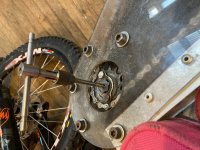
The QS2000 shaft tapping went without difficulty probably because the shaft end had a bigger tapered entry hole than necessary for the tap to abruptly start cutting threads. The QS 3000 had no taper at the top of the hole and soon the carbide tap tip broke an edge off of one cutter flue -- the tap was now worthless for any hard metal cutting. To get a larger tapered hole at the start of the motor shaft a 1/4" round nosed carbide deburring tool was used to mill into about 1/8" of the end of the motor shaft.
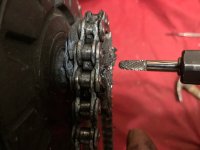
On the shaft 2 washers with 20+mm diameter were added to give a stack height about 0.030" height above the shaft end. Then a big washer was bolted to the shaft end compressing some of that 0.030" overheight washer stack to wege the motor cog onto the widening splines on the other end.
Both the QS 2000 & the QS3000 now have very snug motor cogs.

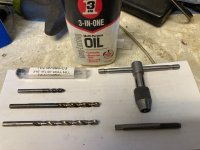
The 3/16" drill mill bit:
https://www.ebay.com/itm/352325412141
The solid tungsten carbide 6mm tap:
https://www.ebay.com/itm/352325412141
Evidence upon completion of 2 bolt installations:
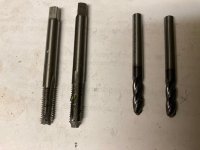
Would the tool tips fair better if the motor had been removed and the work done using a drill press? A hand turned chuck of a drill press gives consistent alignment and still gives a sense of feel when binding occurs.


